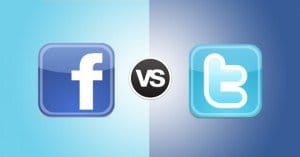 Written by ContentPowered.com
Written by ContentPowered.com
Facebook has long been the go-to social network for paid advertising. There are two reasons for this. This first is value; Facebook’s robust targeting, it’s huge audience and it’s great tools all come together to create something of a perfect storm of advertising. The second reason is more artificial; Facebook has been lowering the amount of reach a given Facebook post has, forcing businesses to pay to reach the number of people they formerly were able to contact with a normal post.
On the other hand, Twitter has been a rising star in the advertising world since they introduced paid ads. Twitter ads aren’t quite the same as Facebook ads; they have less force behind them, fewer placement options, and a whole host of other issues. Still, they exist, and they’re gaining traction. So which is better?
Reach
Facebook has a shockingly huge number of daily active users, and a pool of total users that utterly dwarfs just about every other source on the Internet. On the other hand, Twitter is no slouch itself. At last count, Facebook has 890 million daily active users, with a grand total of 1.4 billion total users. Twitter, meanwhile, has a “mere” 288 monthly users, with around 500 tweets being sent every day. Vine, if you consider it part of Twitter, has some 40 million users.
Therefore, in terms of pure reach, Facebook has the win. On the other hand, you have to consider reliable reach as well.
On Twitter, when you send a Tweet – or run an ad – that artifact of communication is shown to everyone. It’s just up to those people to check at the right time, or to scroll far enough down their feed, to see it. The post is there, it’s not hidden.
On Facebook, meanwhile, only a small percentage of your audience can see a given post. Agorapulse did a study, and found that the percentage varies based on the size of the audience. Pages with under 1,000 fans typically reached 25% of their fans with one post, while pages with more than 100,000 fans only reached around 8%.
Then again, 8% of Facebook’s massive userbase is still more than Twitter’s monthly active user count, so the numbers just don’t matter all that much. What matters is your audience, since most of your ads will be targeting the people who follow you, not the world at large. At least, they will be if you’re any good at advertising.
Ad Performance
There are a number of factors that can go into measuring ad performance. Facebook is cheaper in both CPM and CPC than Twitter, though Twitter doesn’t’ typically publish reams of CPC data. The clickthrough rate for Facebook, however, is significantly lower than Twitter. Twitter ads can perform as much as 10x better.
Facebook, however, wins the game again in terms of average revenue per visitor. In general, Facebook has nearly double the average revenue per visitor of Twitter.
Of course, this is again a game of individuals. Different businesses with different focuses will perform better in different scenarios. You will need to test the average revenue per visitor for each site and determine which is better on your own.
What about mobile, specifically? Facebook has increasingly become a mobile platform, but Twitter began life designed for mobile and has never left that arena. Facebook suffers, because many of their ads revolve around the sidebar, and sidebar ads don’t exist for mobile users. Twitter ads are right in the primary feed, making them much better overall.
It’s up to you if that’s a benefit. It means Twitter is less varied for desktop platforms, where Facebook offers several placements for desktop users. If you make use of them, maybe that’s more valuable to you than the mobile emphasis.
Ad Formats
Facebook used to have dozens of ad formats. It was, by all reports, something of a confusing mess for marketers. Which of the options did you use for which ad? How could you even begin to test them all with a reasonable budget? You simply couldn’t.
Facebook did dial back and simplify their ads, but while some applauded the move, many just realize it was Facebook admitting their ad formats didn’t work. These days, you still have a number of ad formats, but they’re simpler. App ads, domain ads, mobile app ads, offers, page like ads, post link, photo, text and video ads, and sponsored stories. Whew! That’s still quite a lot.
Twitter, meanwhile, has three types of ads corresponding to the three types of information found on the site. These are promoted tweets, promoted accounts and promoted trends. All three of them are clearly denoted, and they’re all valuable in their own ways.
Conclusions
So, to recap. What does Twitter have going for it?
For one thing – and this wasn’t mentioned above – Twitter has some surprisingly great analytics. It doesn’t seem like a site that features 140 character micro-messages would be harvesting all that much data, but you can get a lot about your audience just from a few basic tweets.
Twitter is perfect if the business in question can keep up the sort of casual, conversational tone that’s common amongst Twitter users. On the other hand, businesses trying to use sales language are going to falter and fail. This is true on Facebook as well, but at least Facebook’s sidebar ads work with sales language, even if their news feed posts do not.
Twitter is also astoundingly good for customer service. Many businesses are using the immediate response time as an incentive for quick, robust customer service. Facebook just lacks the messaging options to handle it the same way. That’s not really ad related, but it does make users more inclined to pay attention to your ads.
Facebook, meanwhile, is nice if you want cheap social ads. You won’t get quite as nice returns or click rates from Facebook as you will from Twitter, but you’ll be spending even less. Use it properly and you can rake in the leads.

I feel like I’ve wasted hundreds of dollars with both platforms, though I can’t help but feel Facebook ads has driven a bit more traffic than Twitter. Do you find this to be the case usually?